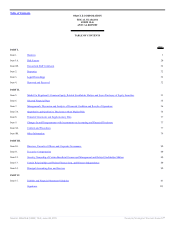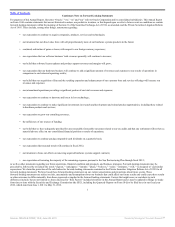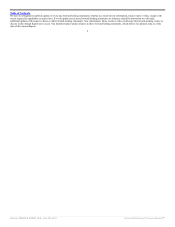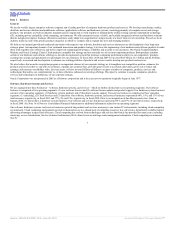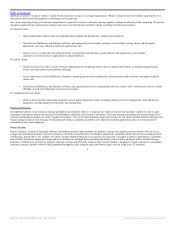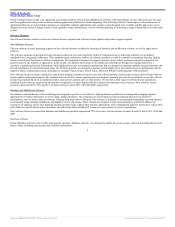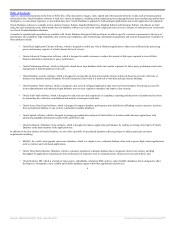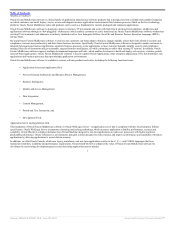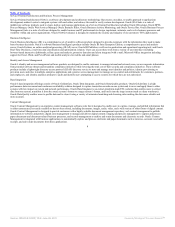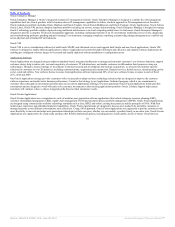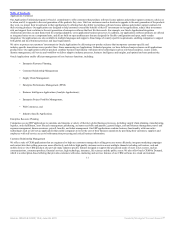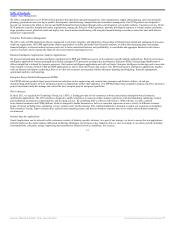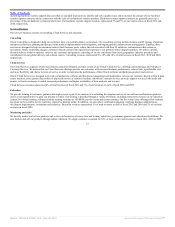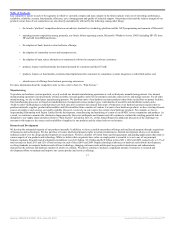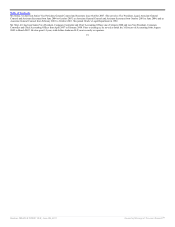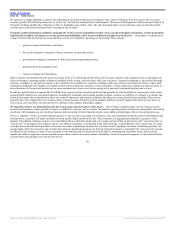Oracle 2010 Annual Report Download - page 14
Download and view the complete annual report
Please find page 14 of the 2010 Oracle annual report below. You can navigate through the pages in the report by either clicking on the pages listed below, or by using the keyword search tool below to find specific information within the annual report.
Table of Contents
Oracle Enterprise Manager
Oracle Enterprise Manager is Oracle’s integrated enterprise IT management solution. Oracle Enterprise Manager is designed to combine the self-management
capabilities built into Oracle products with its business-driven IT management capabilities to deliver a holistic approach to IT management across the entire
Oracle technology portfolio including Oracle Database and Oracle Exadata, Oracle Fusion Middleware and Oracle Exalogic, Oracle Applications, Oracle Solaris,
Oracle Linux, Oracle VM, and our complete hardware portfolio including our servers, storage and networking. Oracle Enterprise Manager is designed to manage
Oracle’s technology portfolio whether deployed using traditional architectures or in cloud computing architectures. In both cases, Oracle Enterprise Manager is
designed to provide a complete IT lifecycle management approach, including configuring elements of an IT environment; monitoring service levels; diagnosing
and troubleshooting problems; patching and provisioning IT environments; managing compliance reporting; and providing change management in a unified way
across physical and virtualized IT environments.
Oracle VM
Oracle VM is server virtualization software for both Oracle SPARC and x86-based servers and supports both Oracle and non-Oracle applications. Oracle VM
software is designed to enable different applications to share a single physical system for higher utilization and efficiency and simplify software deployment by
enabling pre-configured software images to be created and rapidly deployed without installation or configuration errors.
Applications Software
Oracle Applications are designed using an industry standards-based, integrated architecture to manage and automate customers’ core business functions, support
customer choice, help to reduce risk, cost and complexity of customers’ IT infrastructures, and enable customers to differentiate their businesses using our
technologies. Through a focused strategy of investments in internal research and development and strategic acquisitions, we also provide industry-specific
solutions for customers in over 20 industries, including communications, engineering and construction, financial services, health services, manufacturing, public
sector, retail and utilities. New software license revenues from applications software represented 28% of our new software license revenues in each of fiscal
2011, 2010 and 2009.
Our Oracle Applications strategy provides customers with a secure path to adopt our latest technology advances that are designed to improve the customer
software experience and enable better business performance. Central to that strategy is our Applications Unlimited program, which is our commitment to
customer choice through our investment and innovation in our current applications offerings. Our next-generation Oracle Fusion Applications build upon this
commitment and are designed to work with and evolve customer investments in their existing applications portfolio. Oracle Lifetime Support helps ensure
customers will continue to have a choice in upgrade paths based on their enterprises’ needs.
Oracle Fusion Applications
Oracle Fusion Applications are a comprehensive suite of modular, next-generation software applications that include enterprise resource planning (ERP),
customer relationship management (CRM), supply chain management (SCM) and enterprise project portfolio management (EPPM). Oracle Fusion Applications
are designed using commercially-available technology standards such as Java, BPEL and others, existing best practices and the principles of SOA. With their
tailored user experience and embedded analytical capabilities, Oracle Fusion Applications are designed to increase user productivity and allow customers to
manage functions across different environments more effectively. Using a SOA approach, Oracle Fusion Applications are engineered to provide customers with
more flexibility to innovate and adopt next-generation technologies at their own pace, whether via one module, a product family or an entire suite. Oracle Fusion
Applications are engineered to be cloud-ready and thus offer flexible deployment options, including private clouds, public clouds or Oracle Cloud Services.
10
Source: ORACLE CORP, 10-K, June 28, 2011 Powered by Morningstar® Document Research℠


